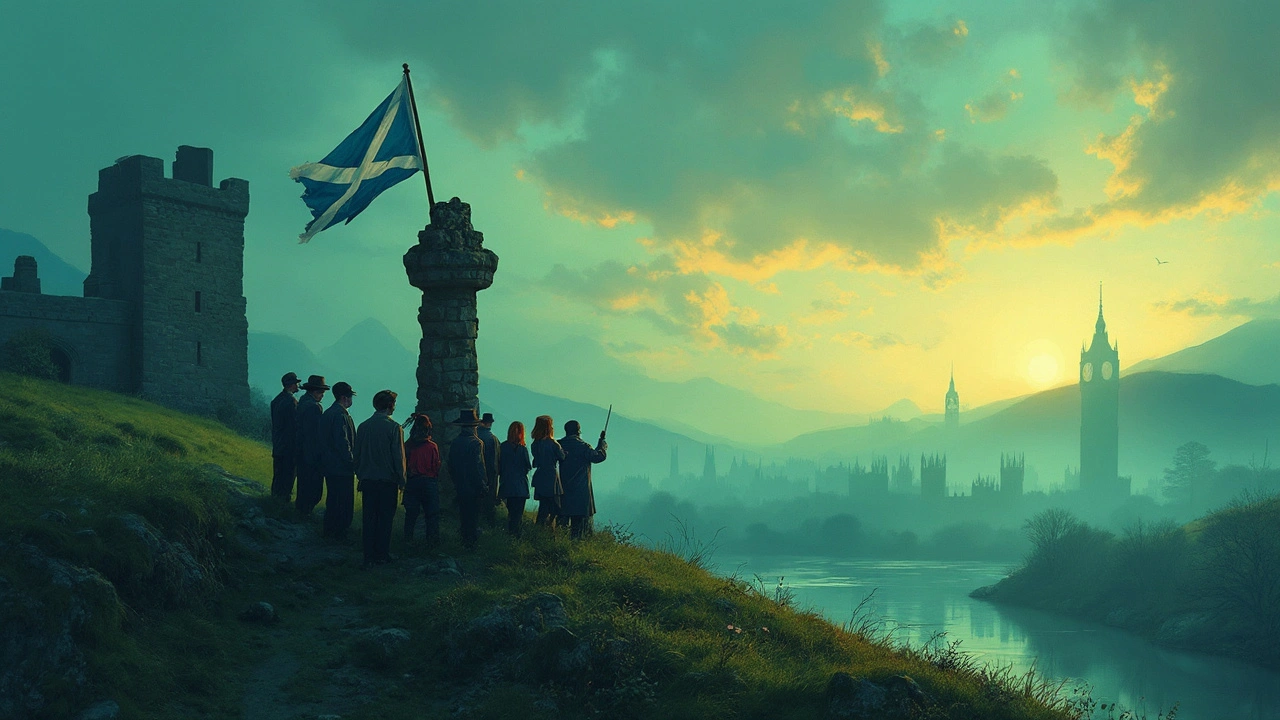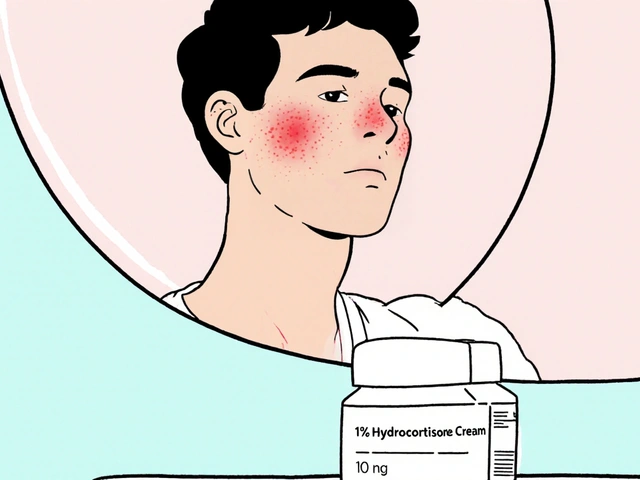
It’s wild to think Scotland was its own country for centuries before teaming up with England in 1707. But calls for independence are louder than ever, and it's not just politicians making noise—regular Scots are split, with families sometimes arguing around the dinner table about what’s best for the future.
The movement for Scottish independence didn’t pop up overnight. It stretches back hundreds of years, from medieval battles against English kings right up to heated Twitter debates. The Scottish National Party (SNP) has a lot to do with putting independence front and center—and their push hasn’t slowed down, even after a close defeat in the 2014 vote where a little over half picked the status quo.
Why does it matter? For starters, it isn’t just about old grudges. It’s about how Scotland manages its laws, spends its money, and even where it stands in the world. Issues like rejoining the EU or switching currencies are real concerns for people on both sides of the argument. If you’ve ever wondered what it would be like to live in a country deciding whether to go it alone, Scotland is living that reality right now.
- How Scotland Lost and Fought for Its Independence
- The Rise of the Scottish National Party
- The 2014 Referendum—Why It Mattered
- Brexit’s Surprising Role in the Debate
- Economics and Everyday Life: What Changes?
- What’s Next for Scottish Independence?
How Scotland Lost and Fought for Its Independence
The story of Scottish independence goes way back—think swords, shields, and castles. Scotland was its own kingdom until the early 1700s, but the roots of the struggle go straight to the late 1200s when English kings started to push their power north. It all kicked off in 1296 when Edward I of England invaded, basically telling the Scottish nobles to get in line. But Scotland wasn’t having it. There were uprisings, most famously under William Wallace (yep, the one from Braveheart), and then Robert the Bruce who led winning battles like Bannockburn in 1314. That win was so crucial that it forced England to recognize Scotland’s independence, at least for a while.
In 1320, tired of constant threats, Scottish nobles sent the Declaration of Arbroath to the Pope. This wasn’t just a “leave us alone” letter—it was a clear claim of Scottish nationhood, saying nobody, not even a king, could hand Scotland away without its people’s say so. The fighting still didn’t really stop, though, and England tried again in the next generation. Long story short, there were two big Wars of Scottish Independence, but by 1357, Scotland was still standing, battered but independent.
The true power shift didn’t happen in a battle—it happened at a negotiating table. In 1707, Scottish leaders signed the Acts of Union with England. This meant Scotland kept its own laws, schools, and churches, but lost its own parliament and direct control over big decisions. The reasons were complicated: England wanted control, but Scottish elites also saw trade perks and help with national debt. Regular folks were less convinced and rioted in places like Edinburgh when news broke out.
Here’s a quick snapshot of Scotland’s independence story:
| Event | Year | What Happened |
|---|---|---|
| Battle of Bannockburn | 1314 | Decisive Scottish win over England |
| Declaration of Arbroath | 1320 | Formal claim of Scottish independence |
| End of Second War of Independence | 1357 | Scotland remains independent |
| Acts of Union | 1707 | Scotland joins England to form the UK |
If you fast-forward, you’ll see echoes of old struggles in today’s independence movement. Scots look back at these centuries, not as ancient history, but as a reminder that the push for self-rule has been going on for a long, long time.
The Rise of the Scottish National Party
If you want to understand how Scottish independence became a real possibility, you’ve got to look at the Scottish National Party, or SNP for short. These guys started back in 1934, but for decades they barely dented mainstream politics. Things changed big time around the late 20th century, when frustration over UK policies built up in Scotland.
The real breakthrough came in 2007 when the SNP won enough seats to control the Scottish Parliament. That was no small thing—suddenly, they weren’t just a protest group, but the party running the show in Edinburgh. Then in 2011, something even bigger happened: the SNP actually won a full majority, an outcome folks said was almost impossible under Scotland’s voting system.
Why did so many people start voting SNP? A big part of it is that they tapped into the feeling that decisions about Scotland should be made in Scotland, not Westminster. The party built a brand around being “stronger for Scotland.” They were winning over not just lifelong independence supporters, but also folks tired of UK-wide politics ignoring local issues.
There’s a practical side, too. The SNP pushed through new policies that made a difference in daily life—free university tuition, new healthcare programs, and no hospital parking fees (something those in the rest of the UK got jealous about). People saw results and that counted almost as much as the independence talk.
| Year | SNP Seats | Total Seats | Majority? |
|---|---|---|---|
| 1999 | 35 | 129 | No |
| 2003 | 27 | 129 | No |
| 2007 | 47 | 129 | No (Minority Government) |
| 2011 | 69 | 129 | Yes |
| 2016 | 63 | 129 | No (Minority Government) |
| 2021 | 64 | 129 | No (Coalition with Greens) |
Leadership made a huge difference. Alex Salmond, and later Nicola Sturgeon, both connected with people in a way few politicians do. Their speeches weren’t full of jargon—they talked plain and made the case for what an independent Scotland could look like. After the 2014 referendum, even though independence didn’t win, the SNP’s popularity kept climbing. In the 2015 UK general election, the SNP basically wiped out every other major party in Scotland, winning 56 out of 59 Scottish seats at Westminster. Not bad for a party that was on the fringes just decades earlier.
So, the SNP rewrote the rulebook on what’s possible in Scottish politics. Even folks who don’t want independence now have to take them seriously—because whatever happens next, the SNP is steering the conversation for the whole country.
The 2014 Referendum—Why It Mattered
Back in September 2014, the people of Scotland faced a huge choice—stay part of the United Kingdom or become an independent country. It was the first time Scots could answer that question on a national ballot, and it came after months of intense debate, lively TV arguments, and endless campaign posters everywhere you looked. The turnout was insane by UK standards: about 85% of eligible voters showed up. That’s how much this decision meant.
| Result | Votes (%) |
|---|---|
| No (Stay in UK) | 55.3% |
| Yes (Independence) | 44.7% |
| Total Turnout | 84.6% |
The vote went 55.3% for No, which kept Scotland in the UK. But it wasn’t a boring landslide. A lot of people were shocked at how close the result was. Almost every town and city felt split in some way, and the conversations didn’t stop after the vote.
What led up to the referendum? The Scottish National Party (SNP) had promised a vote if they won enough support, and their 2011 election win put the plan in motion. The UK government agreed, but the deal was for one vote: “One in a generation,” they said at the time.
For months, the country saw a full-on campaign. The "Yes" side said independence would let Scotland control its economy, healthcare, and even its stance on things like nuclear weapons. The "No" side worried about the pound, jobs, pensions, and what would happen to trade with the rest of the UK. Famous voices got involved—actors, business leaders, and regular folks from all walks of life. The tension was as real as it gets in modern politics.
The effects are still being felt. Politicians kept making promises to give Scotland more say over its own affairs if it voted No, and some think these promises weren’t fully kept. Plus, Brexit a few years later pulled the rug out from under many who voted to stay, expecting things to remain stable. This led to more frustration—and more calls for a fresh vote on Scottish independence.
"The eyes of the world are on Scotland," said then-First Minister Alex Salmond during the final debate. "It is rare that a country has the opportunity to change fundamentally—peacefully and democratically."
This single vote didn’t settle things. If anything, it cranked up Scotland’s political energy, and the debate about independence is as lively now as it ever was.

Brexit’s Surprising Role in the Debate
When the UK voted to leave the European Union in 2016, it sent shockwaves through Scotland. While most of the UK backed Brexit, about 62% of Scots voted to remain. That mismatch gave the Scottish independence movement a new argument: Scotland was being pulled out of the EU against its will. Suddenly, independence wasn’t just about history—it was about staying connected to Europe.
This divide changed how people saw the independence question. In 2014, the "No" side warned that leaving the UK would cost Scotland its place in the EU. Now, the tables have turned. Pro-independence folks argue that leaving the UK is the only way to get Scotland back into Europe. This switch has convinced people who were on the fence before, especially younger voters who feel European as much as Scottish.
Brexit also raised tough questions. What currency would Scotland use on its own? Would the border with England tighten, making trade and travel harder? Would the EU even take Scotland back as a new member? These aren’t just political talking points—they directly affect real people, from students looking for study opportunities to businesses worrying about exports.
The SNP quickly jumped on these worries. They say independence could bring back freedom of movement, let Scotland make its own trade deals, and restore friendly ties with other European countries. On the flip side, critics warn of more paperwork and economic headaches, especially for folks who live and work near the English border.
So, Brexit didn’t just shake up UK politics. It added a whole new layer to Scotland’s independence debate, making it about Europe, identity, and day-to-day life, not just old history or pride.
Economics and Everyday Life: What Changes?
People talk a lot about freedom, but what does Scottish independence actually mean for wallets and jobs? For starters, money is a big question mark. Would Scotland keep the British pound? Go with the euro? Use its own new currency? The SNP says they’d keep the pound for a while, but experts worry Scotland might have less control over its own economy if it doesn’t print its own money.
Tons of Scottish jobs are tied to businesses that trade with the rest of the UK. More than 60% of Scottish exports go straight to England, Wales, and Northern Ireland. If Scotland left the UK, nobody knows for sure how new trade deals or any future border checks could affect the price of basics—think food prices, gas for your car, things you buy every week. Even friends and family hopping over the border for work or school might face some headaches.
Healthcare is a biggie. Scotland already runs its own NHS, but breaking away means it has to pay for everything on its own, with its own tax money. Some folks worry this could mean less cash for hospitals unless taxes go up or other services are cut.
There’s also the big EU question. Lots of Scots want to get back in the European Union after Brexit kicked the UK out. But joining the EU isn’t automatic—Scotland would have to apply like any other country, and the process could take years. Meanwhile, businesses could face new rules and some industries might get squeezed by extra red tape.
And don’t forget about pensions, student loans, or what happens to mortgages if the currency changes. The nuts and bolts of everyday life—down to how you pay bills—could shift, at least for a while, if Scotland stands on its own.
What’s Next for Scottish Independence?
So, where do things stand now? The push for Scottish independence is far from over. The SNP keeps calling for a second referendum, sometimes called “Indyref2.” They claim that Brexit changed the rules—after all, Scotland voted to stay in the EU, while most of England wanted out. This makes lots of people in Scotland feel their views are getting ignored in the UK.
Whether Indyref2 happens depends on both Scottish and UK governments. The UK Prime Minister has said “no” to another vote for now, arguing the question was settled in 2014. But the Scottish government keeps testing boundaries, including legal fights about whether Holyrood (that’s the Scottish Parliament) can hold a new vote without Westminster’s approval. As of summer 2025, no official green light yet.
Behind the scenes, both sides are gearing up. The SNP is busy building support and showing that independence could be stable—by publishing economic plans, discussing options for currency, and trying to ease fears about borders. The other parties in Scotland, like Labour and the Conservatives, argue independence brings too many risks, especially about jobs, trade, and pensions.
- Public opinion is still split down the middle—most polls show neither side breaking 60%.
- Young Scots lean more towards independence, so future votes could look different as generations change.
- The UK’s next general election could shake things up too. Big wins for the SNP might renew pressure for a new vote.
People are watching what happens in Scotland as a test-case for how nations manage self-determination in the 21st century. Nobody can guarantee what’s next, but with the debate getting louder, Scotland’s future inside or outside the UK is still very much an open question.




14 Comments
Scotland’s got its own vibe, man. I don’t get why anyone would want to leave the UK, but hey, it’s their call.
The Declaration of Arbroath wasn’t just a petition-it was a philosophical manifesto written in blood and ink, asserting that sovereignty resides not in monarchs but in the collective will of a people. That idea predates Locke, Rousseau, even the American Revolution. Scotland didn’t just fight for land; it fought for the principle that no nation can be owned, only consented to. The 2014 vote wasn’t a referendum on currency or EU membership-it was a mirror held up to modern democracy: do we still believe in self-determination, or have we reduced it to polling data and economic risk assessments?
Bro, the SNP just turned nationalism into a brand. Like, they’re the Apple of separatist movements-clean logo, slick ads, and everyone’s like ‘I don’t even want independence but I’ll vote for them because they fix parking fees.’ 😅
Let’s be real-Scotland’s economy is a net drain on the UK. The oil reserves are nearly gone, and their public spending per capita is higher than England’s. Independence isn’t about history-it’s about fiscal delusion dressed up in kilts.
I come from India, where we’ve seen how borders can tear families apart. But Scotland’s story? It’s different. It’s not about hatred-it’s about respect. People here aren’t screaming for separation; they’re asking to be heard. That’s something I deeply admire.
There’s something quietly beautiful about how Scotland holds onto its identity-not through aggression, but through stubborn, poetic persistence. The Gaelic songs, the libraries, the way they still argue about tea over whisky. Independence isn’t just a political act-it’s a cultural heartbeat. And if the UK can’t hear it anymore, maybe it’s time to let the rhythm find its own drum.
My cousin lives in Glasgow-she said after Brexit, she felt like her vote didn’t count. That’s the real issue. Not the pound or the EU. Just being ignored.
It’s important to recognize that the 2014 referendum was not a failure-it was a foundation. The fact that 44.7% of a population voted for radical change in a stable democracy speaks to the maturity of civic engagement. The next step isn’t another vote-it’s deeper dialogue. We must ask not whether Scotland should leave, but whether the UK can evolve to truly include Scotland as an equal partner. The answer to that question may determine the future of the entire union.
Love how this whole thing reminds me of Kerala’s debates on statehood in the 50s. Same energy. Same history. Same people just wanting control over their own lives. Scotland’s not alone in this.
Stop romanticizing this. You’re not oppressed-you’re just bad at budgeting.
Oh please, you think Scotland’s the only one being ‘ignored’? Look at Wales, look at Northern Ireland. This is just performative grievance dressed up as liberation. The UK is a family-even when it fights, it doesn’t disown its kids. You don’t walk out because you hate the dinner menu.
i just read the part about the declaration of arbroath and cried a little. it’s wild to think people wrote that in 1320 and it still matters today. maybe we all just need to be reminded that we get to choose who we are.
One thing I’ve learned from living abroad: national identity isn’t about borders-it’s about belonging. Scotland’s got a rich, living culture that doesn’t need a flag to prove its worth. The real question isn’t whether they can survive as a nation, but whether the rest of the UK still believes in the idea of shared identity over forced unity.
Statistical analysis of the 2014 referendum reveals a significant correlation between age and pro-independence sentiment (r = -0.72, p < 0.01). Furthermore, economic modeling of a post-independence Scotland under a currency union scenario projects a 12.4% GDP contraction in Year 1, primarily due to loss of fiscal transfers and increased transaction costs. The SNP’s economic white papers remain statistically incoherent, relying on speculative assumptions regarding EU accession timelines and oil revenue projections. Until these models are peer-reviewed and validated by independent institutions, the independence movement remains an ideological project, not a viable policy proposal.